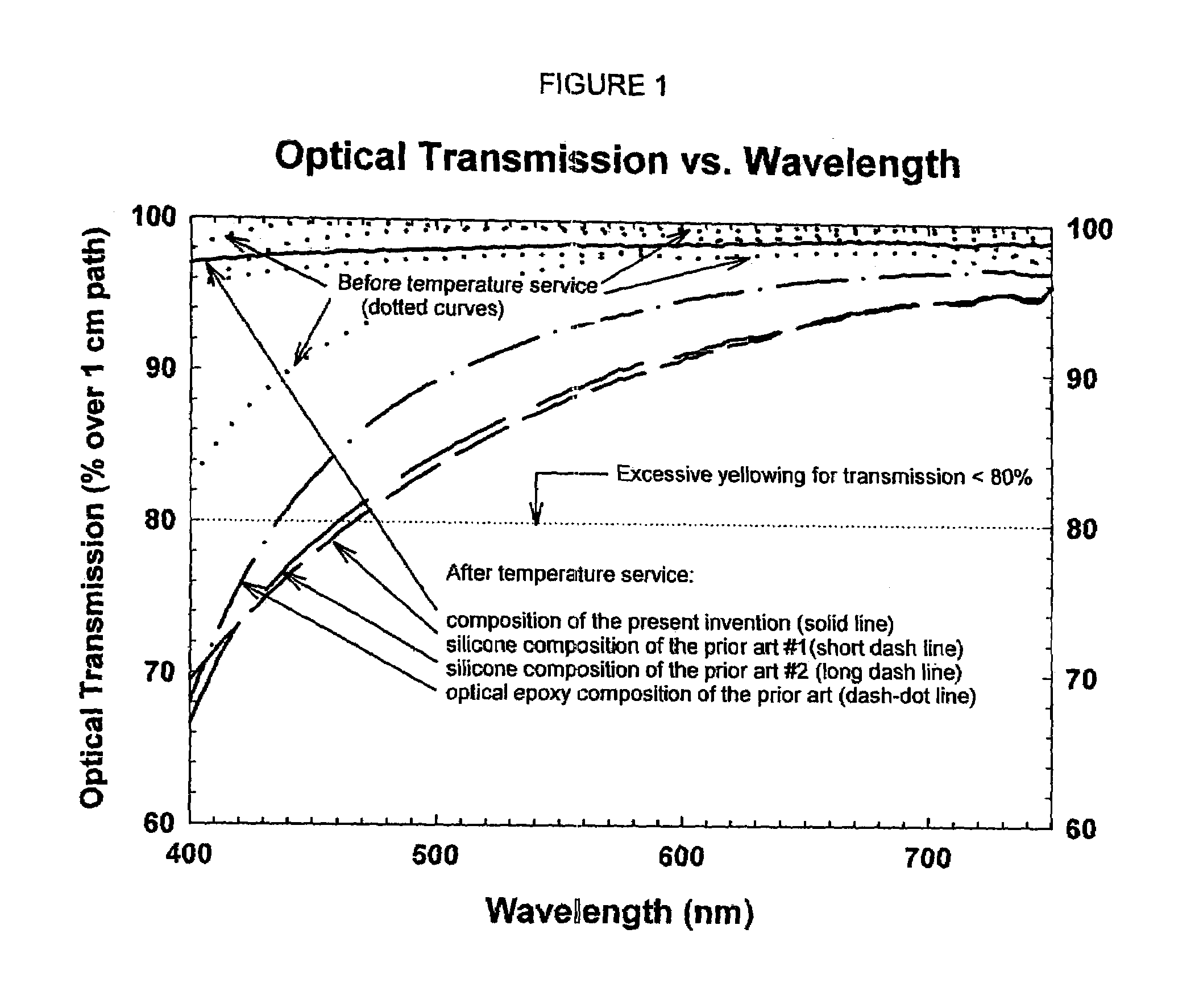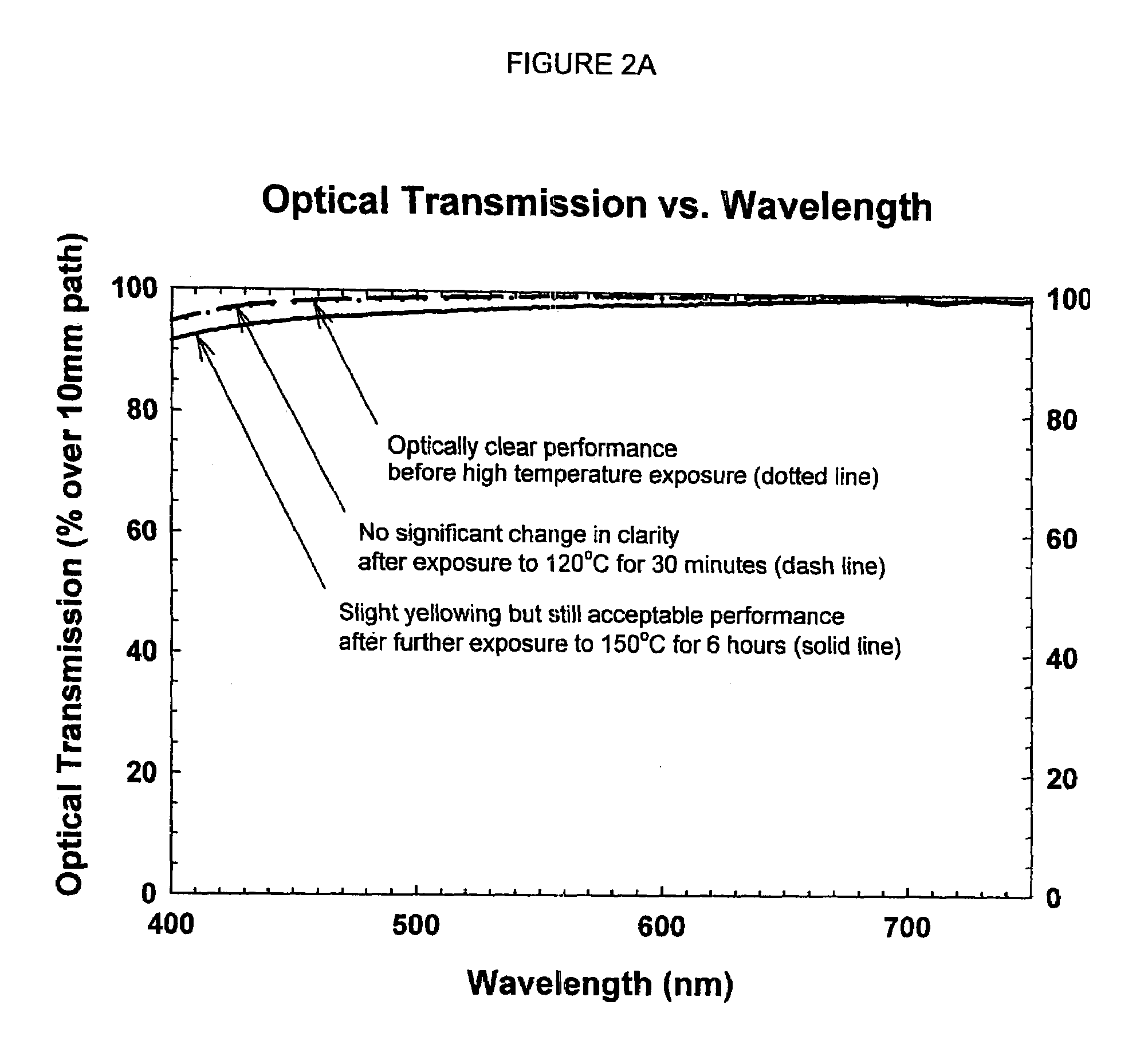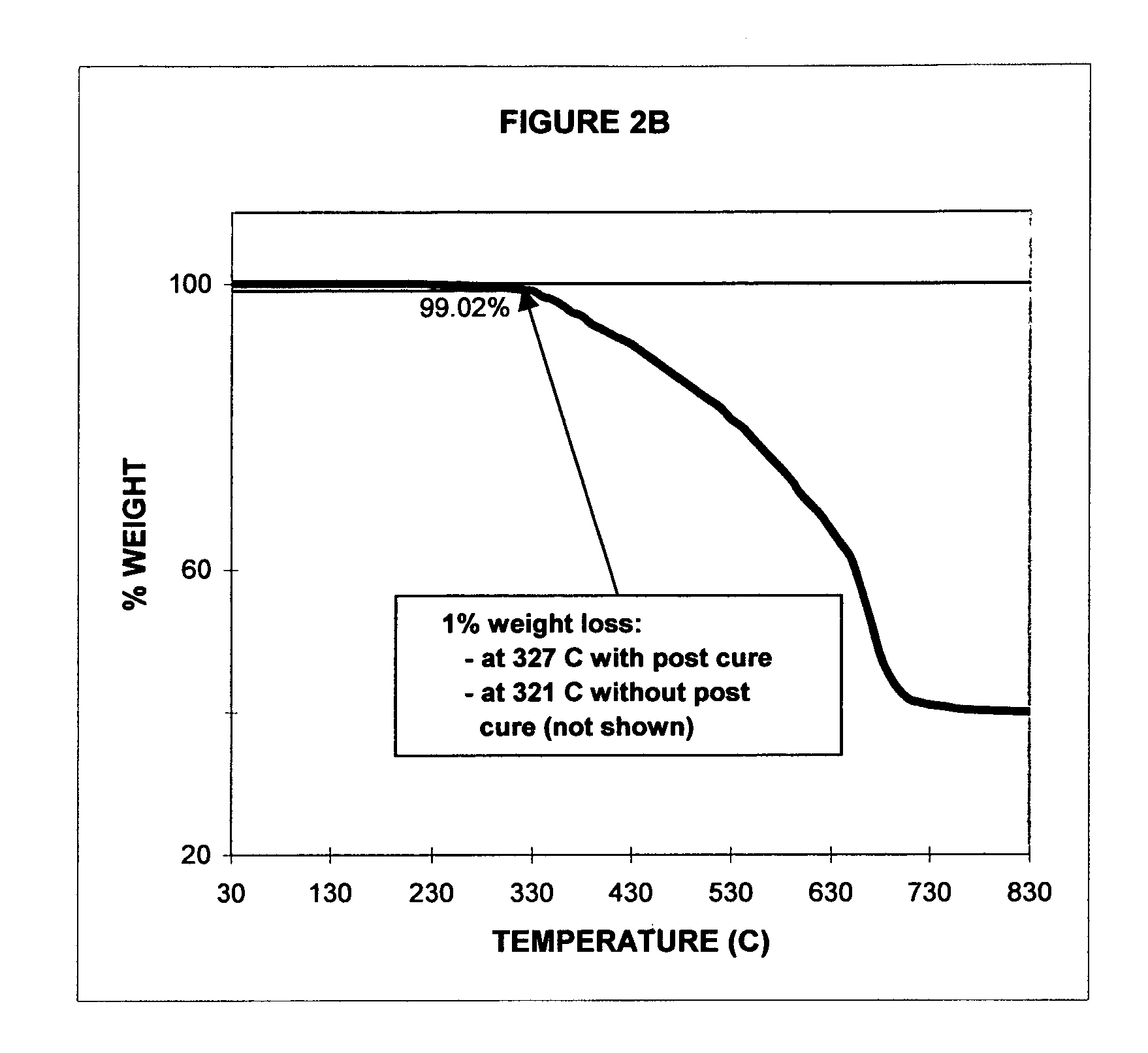Optically clear high temperature resistant silicone polymers of high refractive index
a silicone polymer and high refractive index technology, applied in the field of silicone polymers, can solve the problems of high attenuation of optical polymer materials, requirement for optical polymer materials to withstand high temperatures without degradation of mechanical or optical properties, and achieve the effect of high refractive index
- Summary
- Abstract
- Description
- Claims
- Application Information
AI Technical Summary
Benefits of technology
Problems solved by technology
Method used
Image
Examples
example 1
Properties of Formulation
[0121]
Property (at 25° C. unless noted)Test MethodTypical ValueCure Processing CharacteristicsUncured mixed viscosityASTM D-1084200 cPViscosity increase at 8 hrsASTM D-1084+10 to +15%Pot Life (2 × viscosity)ASTM D-10843 daysCure Time at 100° C. (212° F.)Visual 3 hoursCure Time at 120° C. (248° F.)Visual15 minutesCure Time at 150° C. (302° F.)Visual 3 minutesCure Time at 200° C. (392° F.)Visual45 secondsOptional Post CureASTM D-2240>150° C. for >30for MaximumminutesDurometer hardnessCured Mechanical PropertiesCure Shrinkage, by volumeASTM D-1217 2%Physical ConsistencyVisualLike “hardrubber”Shore A DurometerASTM D-224050Specific GravityASTM D-1217 1.12Cured Thermal PropertiesGlass TransitionTMA3° C.Thermal Expansion by VolumeASTM D-19035 × 10−4 cc / cc / ° C.TGA Take-off (1% wt. loss,ASTM D-3850327° C. (see FIG.10° C. / min. in air)2B)Cured Optical PropertiesAppearanceVisualCrystal clearRefractive Index, 589 nmASTM D-1218 1.567Refractive Index vs.ASTM D-1218−3.9 × 1...
example 2
Properties of Formulation
[0127]
Property (at 25° C. unless noted)Test MethodTypical ValueCure Processing CharacteristicsUncured mixed viscosityASTM D-1084200 cPViscosity increase at 8 hrsASTM D-1084+5%Pot Life (2 × viscosity)ASTM D-1084>1 dayCure Time at 150° C. (302° F.)Visual30 minutesCured Mechanical PropertiesPhysical ConsistencyVisualLike “gel”Shore 00 DurometerASTM D-224020Specific GravityASTM D-1217 1.12Cured Optical PropertiesAppearanceVisualCrystal clearRefractive Index, 589 nmASTM D-1218 1.570Refractive Index vs.ASTM D-1218−4.0 × 10−4 / ° C.Temp., 589 nmRefractive Index vs. Wavelengthprism coupler(see FIG. 3B)Optical AbsorptionSpectrophotometer(see FIG. 3A)
[0128]Measured data pertaining to optical clarity, high temperature service, and high refractive index are given in FIGS. 3A and 3B. FIG. 3A shows the optical transmission for this Example 2 formulation is better than 95% over a 1 centimeter path length (dotted line) and remains so, even after exposure to a temperature serv...
example 3
Properties of Formulation
[0132]
Property (at 25° C. unless noted)Test MethodTypical ValueCure Processing CharacteristicsUncured mixed viscosityASTM D-1084350 cPViscosity increase at 8 hrsASTM D-1084+4%Pot Life (2 × viscosity)ASTM D-1084>24 hoursCure Time at 120° C. (248° F.)Visual 17 hoursCure Time at 150° C. (302° F.)Visual 4 hoursCured Mechanical PropertiesPhysical ConsistencyVisualLike “gel”Shore 00 DurometerASTM D-224020Specific GravityASTM D-1217 1.11Cured Optical PropertiesAppearanceVisualCrystal clearRefractive Index, 589 nmASTM D-1218 1.550Refractive Index vs.ASTM D-1218−3.9 × 10−4 / ° C.Temp., 589 nmRefractive Index vs. Wavelengthprism coupler(see FIG. 3B)Optical AbsorptionSpectrophotometer(see FIG. 3A)
[0133]As is shown in FIG. 4A, Example 3 has excellent optical clarity in the visible range before exposure to 120° C. for 6 hours (dotted line) and remains so after such exposure (dashed line). The composition has a refractive index in the range of 1.55 as shown in FIG. 4B. This...
PUM
| Property | Measurement | Unit |
|---|---|---|
| Temperature | aaaaa | aaaaa |
| Fraction | aaaaa | aaaaa |
| Time | aaaaa | aaaaa |
Abstract
Description
Claims
Application Information
 Login to View More
Login to View More - R&D
- Intellectual Property
- Life Sciences
- Materials
- Tech Scout
- Unparalleled Data Quality
- Higher Quality Content
- 60% Fewer Hallucinations
Browse by: Latest US Patents, China's latest patents, Technical Efficacy Thesaurus, Application Domain, Technology Topic, Popular Technical Reports.
© 2025 PatSnap. All rights reserved.Legal|Privacy policy|Modern Slavery Act Transparency Statement|Sitemap|About US| Contact US: help@patsnap.com



